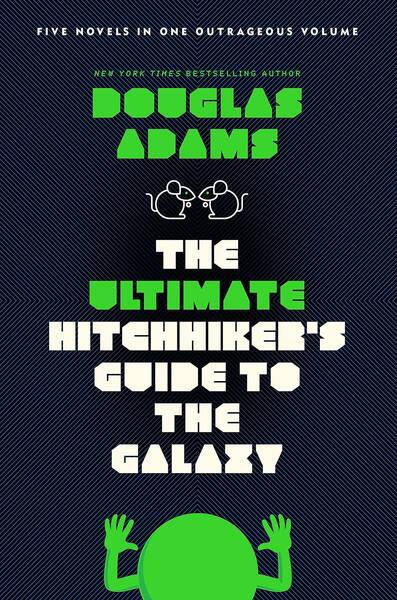🎨 Impressions
Reading Walter Isaacson’s biography of Elon Musk inspired me to re-read this classic silly sci-fi novel. It was one of Elon’s favorite books growing up, released in 1979 when he was 8 years old. The book is silly and childish most of the time, but that’s the charming fun aspect of it and it owns it. When I read it first some 20 years ago as a young adult, I wasn’t swept away and didn’t immediately join the cult following the book has, but I respected it for what it was and I can understand why it found such a base, especially in the technically versed community, also often called the nerds.
There are many clever ideas which surprise you in a pleasant way the first time you read it. The first example being the exposition scene of our protagonist, Arthur Dent, who has his house suddenly demolished by construction workers who need to build a bypass street in that place, citing that the plans have been publicly available in the district’s governing building somewhere in the cellar. Kafkaesque, of course. But then aliens show up and announce they are about to demolish the whole planet Earth, because a hyper passage through space is required right where our home planet is located. The plans had been publicly available at the galactic government building at Alpha Centauri, we could’ve objected. So Earth explodes and the adventures begin.
While the book is short and has several of these excitingly written chapters, I found myself drifting off a lot while reading it. The reason is probably that I usually prefer non-fiction, because stories like these always feel like they don’t affect me at all and waste my time. I guess that’s why the readership of the book is mostly younger and at a stage in life where time feels abundant.
So why does the book have so many fans, including the richest person on Earth, who has made it one of his life’s missions to make human space travel more obtainable? I think it’s because it inspires us. The universe is incomprehensible and huge and exploring it should be our mission. Like Sir Edmund Hillary said after climbing Mount Everest together with Tenzing Norgay as the first people ever, we should explore everything just because it’s there. Because it exists. It’s a fundamental human trait to pursue challenges and explore the unknown.
There are also lots of little bits and pieces in the book which have made it into pop culture. Examples include the term “Googleplex”, which isn’t just only the company’s name for its headquarters, but also played a role in the original creation of the name “Google”, combined with the term googol, meaning a number consisting of a leading 1 with 100 zeros. In the novel, it’s just one of hundreds of made-up words representing some obscure alien things. Then there’s Marvin, the Paranoid Android – which is the name of Radiohead’s most famous album. The words “DON’T PANIC!”, which are written on the literal hitchhiker’s guide to the galaxy, the book within the book. And last not least, the number 42, which is the answer to the question of life, the universe, and everything, and given by the universe’s then most powerful computer.
A copy of the book is currently sitting in the glove compartment of the red Tesla Roadster which is mounted atop of the Falcon Heavy rocket making its way around the solar system forever since 2018.
The book is fun and a quick read. But I probably won’t read its three successor books now.
📔 Highlights
There is a theory which states that if ever anyone discovers exactly what the Universe is for and why it is here, it will instantly disappear and be replaced by something even more bizarre and inexplicable. There is another which states that this has already happened.

Leave a Comment